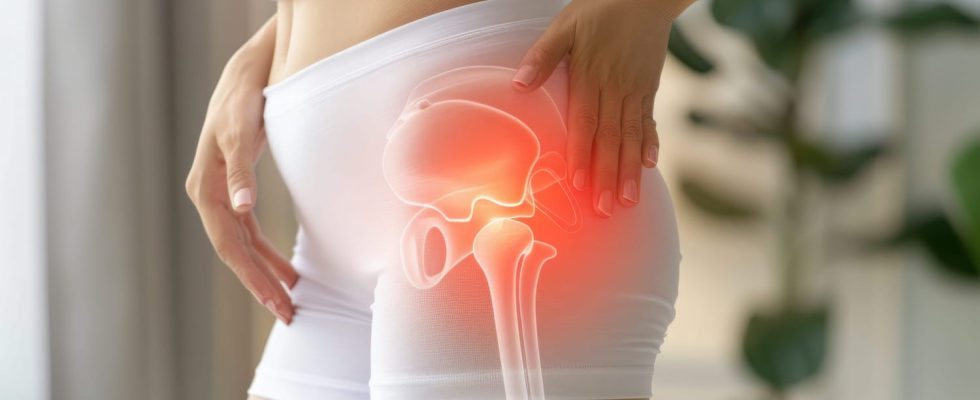Osteoarthritis, tendonitis, bone problems… Our rheumatologist details the possible causes of hip pain according to its manifestations.
Most often, hip pain is located in the inguinal fold (groin) and it will radiate to the front of the leg. It can also manifest as pain in the buttock that radiates behind the thigh. “Localized right or left, the causes of hip pain are the same” explains Professor Aleth Perdriger, rheumatologist, straight away. “If the hip hurts and it is stiff, it is joint pain. If it is tendon pain in the area of a tendon in the buttock or thigh , pain will be felt upon palpation and mobilization against resistance” he continues.
► If the pain manifests itself as groin pain, which radiates to the anterior surface of the thigh, it can reveal a joint problem linked to damage to the joint itself, the coxofemoral joint. This joint pain can be due to osteoarthritis, trauma, overuse of the hip, or be linked to dysplasia (benign malformation of the joint at birth which limits mobility).
► If the pain increases with exercise and walkingthat stiffness is felt in the morning upon waking up, in the joint and that it fades (generally) within a few minutes, it may be osteoarthritis of the hip.
► If the pain is localized around the hip, at the level of the buttock or the outer side of the thigh, it may be tendinitis or bursitis (inflammation of the bursae located at the level of the joints). “This pain is secondary to an inadequate way of working the muscles of the buttock or back which can create muscle imbalances.“, informs the rheumatologist. “The treatment is based on the physiotherapy. A local infiltration of the hip can also be proposed but this procedure must be carried out by a specialist because the hip joint is quite deep, which exposes us to a risk of infection.
► If hip pain is associated with pain in the anterior aspect of the thigh, it can come from damage to the crural nerve, a nerve located above the two sciatic nerves. We then speak of cruralgia. In the event of cruralgia, an examination of the back and nerves is carried out. An imaging test (ultrasound, x-ray, scanner or MRI) helps confirm the diagnosis.
More rarely, joint pain can be of inflammatory origin, reflecting a more general illness, such as an infection or inflammatory rheumatism (arthritis). It can also be associated with bone damage to the femoral head where vascularization is reduced, leading to fragility of the bone. Firstly, the architecture is preserved, then secondly, collapse of the bone will occur. We are talking about osteonecrosis. Hip pain can also come from a visceral pathology in the ovary, testicle, digestive tract, bladder or inguinal hernia.
Treatment will depend on the cause, but it is essential to stay moving to limit the pain. Regularly practicing hip stretches allows you to maintain good mobility for a long time. It is also essential to avoid excess weight which weighs on the joints and accentuates pain and to preserve muscle capital to minimize the impact on the joints. Physical activity In the event of pain in the back, local infiltration and/or physiotherapy may be offered. Referred pain treatment will end the pain felt in the hip“, specifies the rheumatologist.
Thanks to Professor Aleth Perdriger, rheumatologist.
